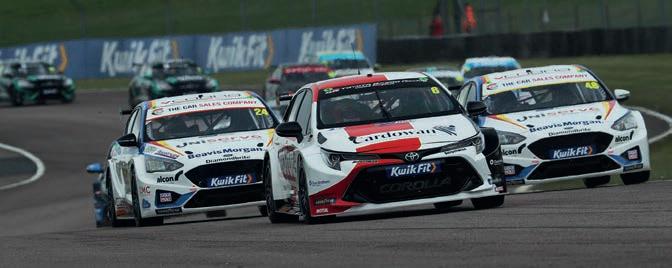
19 minute read
BRITISH TOURING CARS
On the button

Designed to replace the success ballast previously used in the BTCC, the new Cosworth hybrid package offers a unique solution to hybridisation
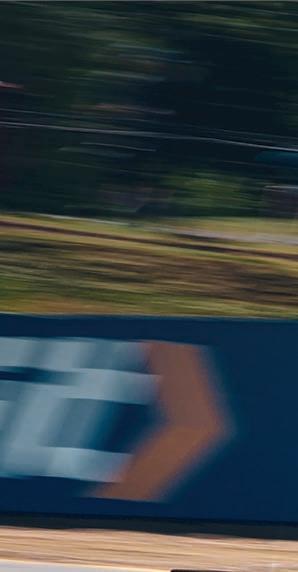
By Stewart Mitchell


At the end of 2019, a tender was awarded to Cosworth by the TOCA-organised British Touring Car Championship (BTCC) to develop a hybrid system for the series. By the middle of 2020, some testing of the system had begun, but Cosworth fi rst had to understand how to build its system alongside the prescribed turbocharged, inline, four-cylinder ICE.
Rob Morrow, now at Delta-Cosworth, was initially project leader but handed over the reins in mid-2021 to Richard Woodgate, lead applications engineer at Cosworth, who was put in charge of the hybrid system and integration of it with the Cosworth 12V electronics. Based in Cambridge, UK, his role is purely working on the BTCC project.

Design philosophy
TOCA’s target for the hybrid drive was 15 seconds of deployment per lap when the system is available. This should translate to that car gaining 15m within those 15 seconds, assuming a corner exit speed of 100km/h. The organising body didn’t want it to act like DRS, only being deployed in some regions of the circuit and only rewarding chasing drivers, as it believes this overtaking is too fabricated. Instead, it wanted a push-to-pass system racers can use at the exit of a corner to try and bring them alongside opponents in the next corner.
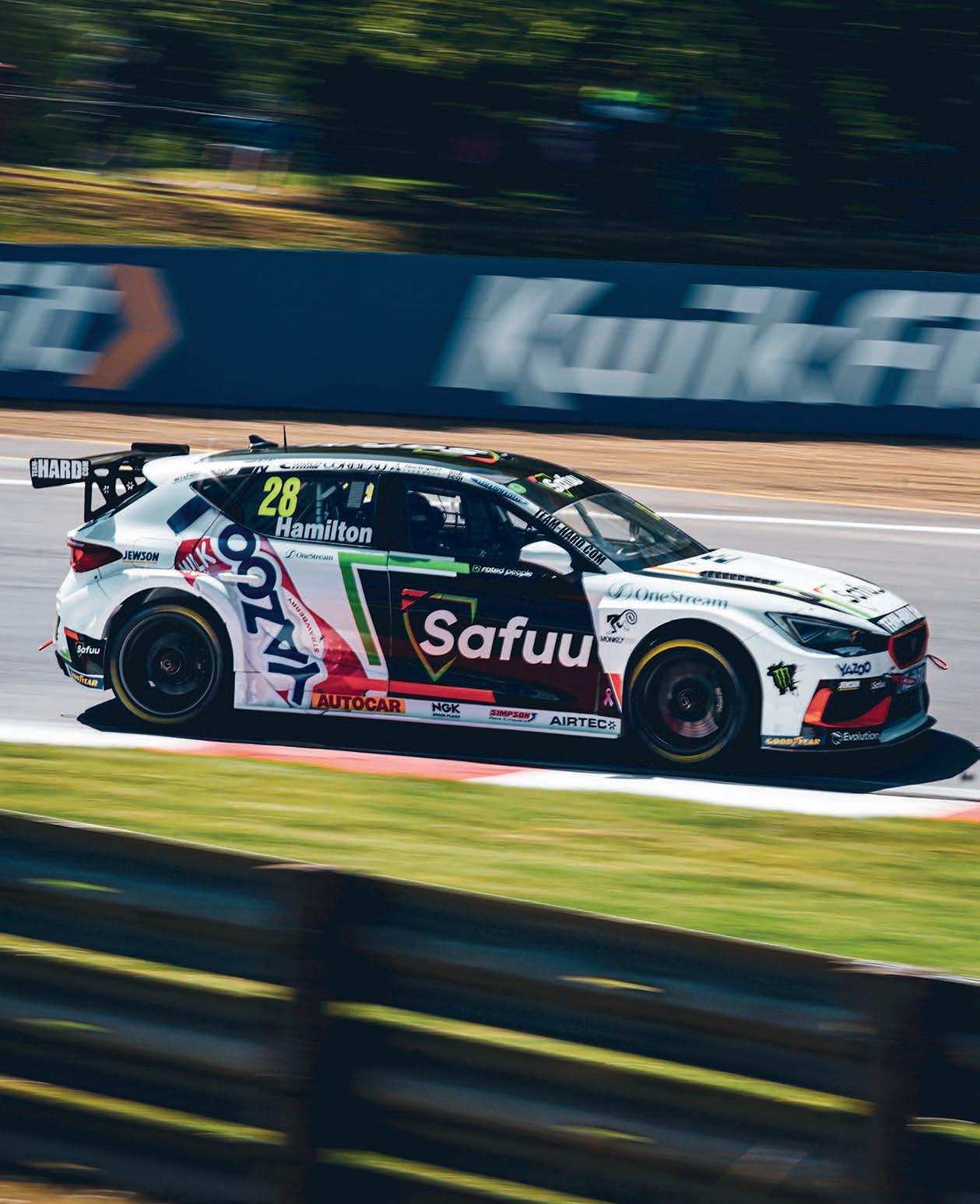
However, the driver in front would also be able to system to defend that position, keeping the racing close.
Cost was a significant consideration for the system. TOCA placed a lease cost limit on what the tender winner could charge. It was therefore evident a custom design would not be appropriate because the cost would have run out of control.
‘The motor, inverter and ancillaries needed to be mostly off-the-shelf components for cost reasons,’ confirms Woodgate. ‘The only component that sits outside of that is the battery, which has been designed uniquely for the BTCC application by Delta-Cosworth.
‘Because this is a hybrid system, and it isn’t the primary drive for the vehicle, peak efficiency isn’t the main driver for the specification. We needed a system that can deliver the required lap deployment duty, and only push enough energy back to the battery so we can recover a portion of that.
‘So, the considerations are slightly different compared to what other hybrid and electric race series demand.
‘We have managed to use a couple of suppliers and produce a safe, cost-effective system that meets all the targets.’
System specification
‘Cosworth hybrid package’ is the official name given to the system developed by Cosworth. It is based on TOCA’s requirement for low voltage (sub 60V) and, uniquely for a motorsport hybrid system, is designed to replace the BTCC’s success ballast concept, allowing it to be a racing tool rather than just a marketing gimmick.
‘BTCC is famous for its overtaking, and TOCA didn’t want to lose that,’ highlights Woodgate. ‘Also, TOCA chose a low voltage operation for ease of use. It means they (teams, marshals and event organisers) don’t have to go through high voltage training, acquire specialist equipment and so on.’
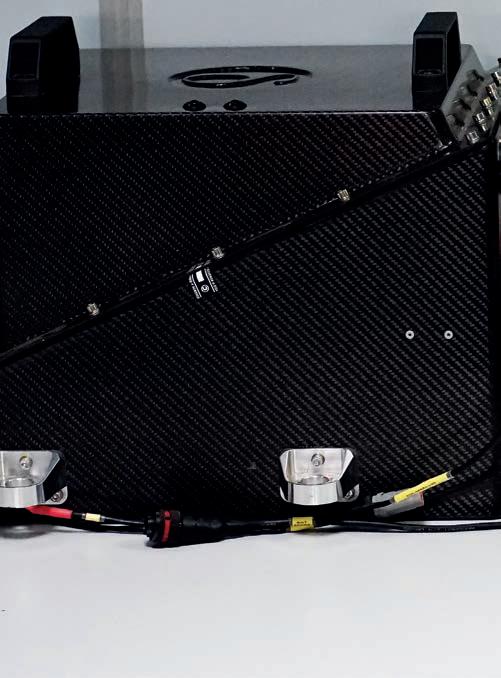
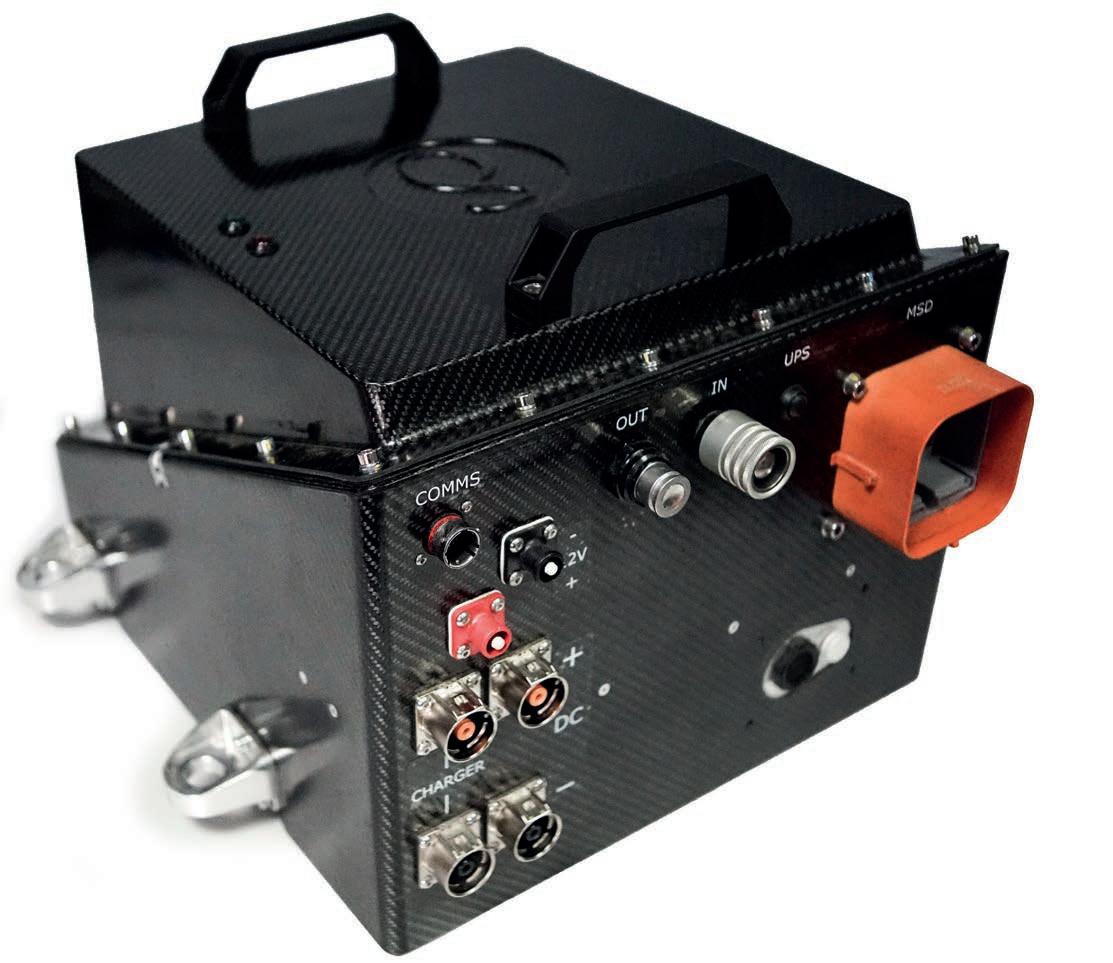
BTCC Cosworth hybrid package components laid out
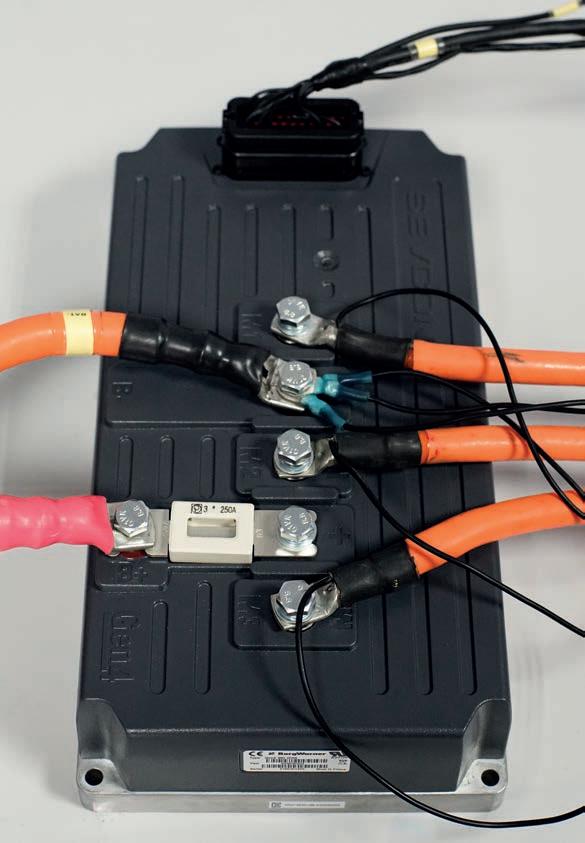
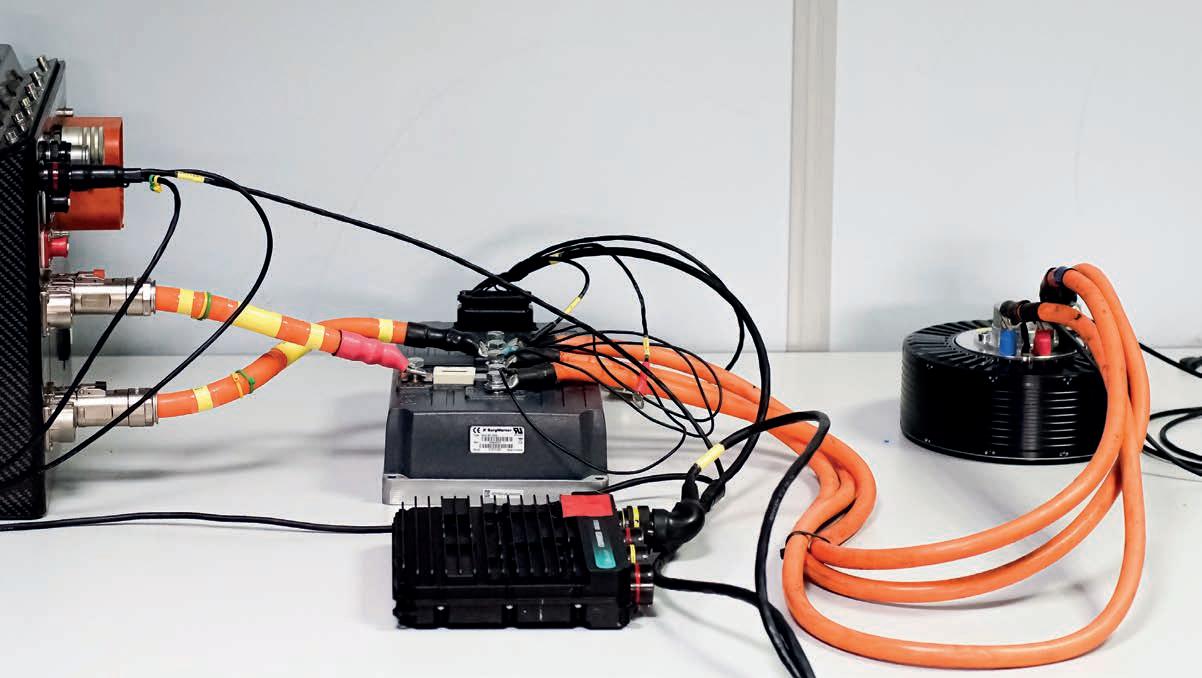
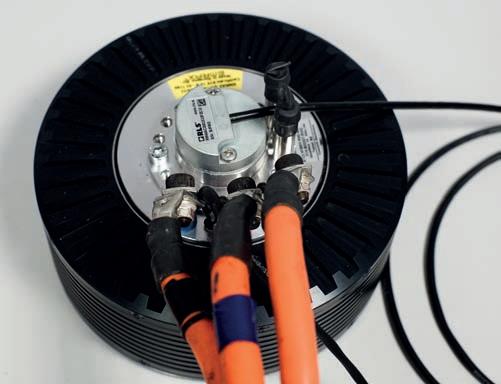
Above: the heart of the system is an EMRAX 188 external rotor, permanent magnet, three-phase electric motor
Left: the Sevcon Gen4 MOSFET-based inverter
Anything below 60V is classed as low voltage, and the Cosworth BTCC hybrid system’s peak voltage is around 56.5-57V from the battery. Running range is between 43 and 57V, with a nominal average about 51V.
The motor is an Emrax 188 – an axial flux, external permanent magnet rotor unit. In terms of control, three phases were deemed sufficient for the application on cost grounds.
‘Obviously, six phases would be great as then you can share your current across more phases, but we were limited by what we could buy off the shelf,’ explains Woodgate.
The motor weighs just 7.3kg and produces 30kW of continuous power and a maximum 50Nm of continuous torque, with a peak of 90Nm. It’s relatively small, too, being 188mm in diameter and 77mm deep.
In other words, ‘an ideal package as an offthe-shelf solution,’ as Woodgate describes it.
The axial flux architecture was chosen for speed matching alongside the ICE as the motor is mounted in parallel to the gearbox, driven off its input shaft. As such, it had to be rpm matched to the engine, and uses what is known as P2 parallel off-axis hybrid architecture, a highly flexible way of facilitating parallel hybridisation.
More specifically, TOCA and Cosworth decided to build the BTCC hybrid unit in a P2 off-axis drive module configuration at a 1:1 ratio, which sees the electric motor drive parallel to the crankshaft axis for a more compact axial package. This minimises the changes necessary to implement it with the existing internal combustion engine and transmission. The design offers compatibility with the series’ racing transmission, and addresses the tight packaging requirements of the BTCC drivetrain.
‘When the tender process went out, we looked at all the available packaging on the gearbox,’ says Woodgate. ‘We chose this solution in terms of power for the voltage range, and its power output is suitable for the speed range. So that was the key winning combination of factors.
‘This axial machine bolts through the centre, and the rotor spinning around the outside gives us a higher torque delivery for the size. That was our main reason for choosing it.’
The continuous power figure of 30kW is achieved most efficiently at 4500rpm, but it can run up to a maximum of 8000rpm for a few seconds with the magnetic field weakening. Being direct drive with the ICE, the electric drive will spin at engine rpm, which, for 95 per cent of a BTCC car’s on-track life, is between 4000 and 7000rpm.
‘Under deployment, we adhere to our current limit of 650 amps, so we’re creating a power limit based on that,’ says Woodgate. ‘We’re normally around 25kW output, which equates to about 43 to 35Nm of torque through that speed range.’
The motor controller is a Sevcon unit supplied by Voltsport, which also performs the calibration of the system.
‘It’s not Formula E performance levels, but it’s quite efficient,’ notes Woodgate. ‘We see 96 per cent efficiency out of it. We couldn’t find anything in the price bracket that will do a better job, so we are happy with it.
‘The Sevcon unit controls the motor directly and is a slave to the Cosworth Antares 8 vehicle control unit [VCU], which runs all systems onboard the car. The Antares 8 VCU controls all the torque demand to and from the hybrid system, and the Sevcon unit delivers what we need to or from the motor, and manages the switching accordingly.’
The switchgear inside the Sevcon part is simple but effective MOSFET technology, with a switching frequency of 12kHz, specified based on the BTCC duty cycle.
Battery technology
The battery design is based on automotive systems, and the BMS software carries a standard automotive safety layer. The battery has been developed around high voltage principles and contains all the necessary interlocked connectors and a manual service disconnect so engineers or marshals can isolate it quickly and easily.
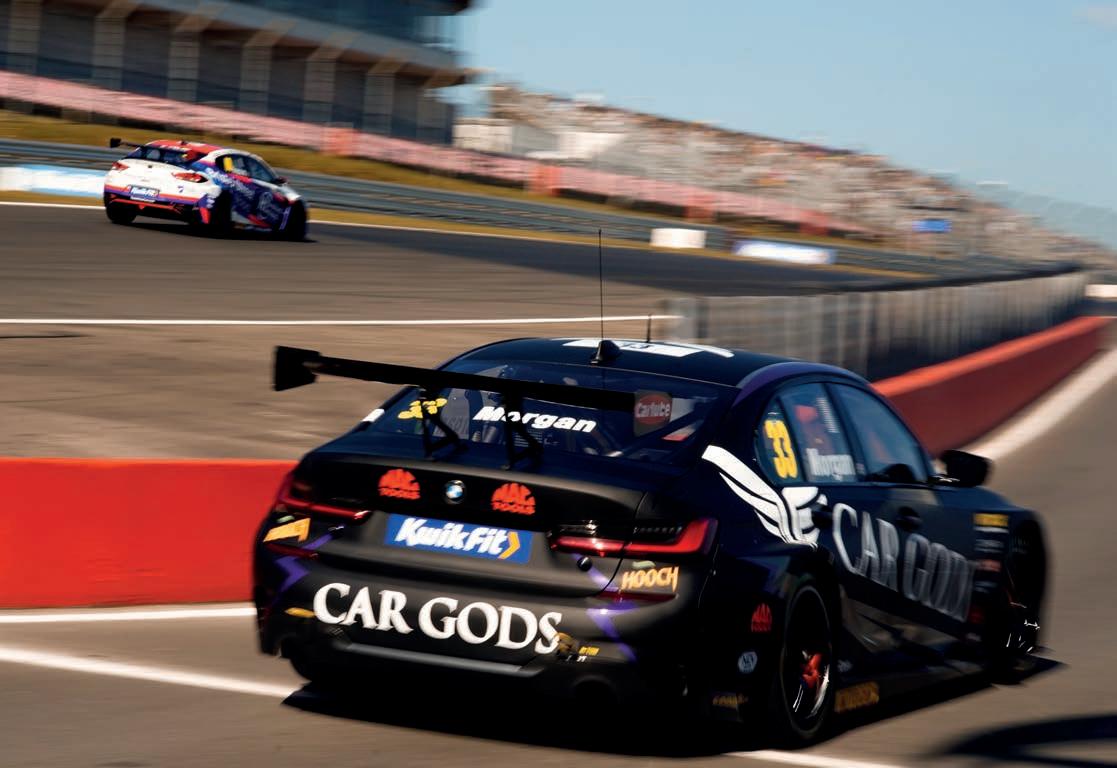
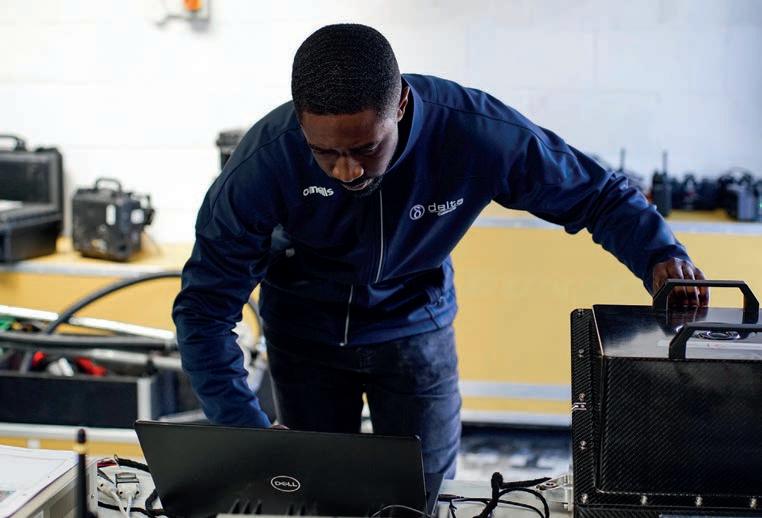
Daniel Osei, control systems engineer at Delta-Cosworth, working on the BTCC hybrid system
The BMS also carries out isolation monitoring and automotive standard safety protocol while in use.
‘We’ve kept the high voltage systems for this battery because if BTCC wanted to go to a higher voltage in the future, people will already be familiar with a certain level of safety involved,’ highlights Woodgate. ‘So, it’s trying to futureproof it a little bit.’
Cosworth chose the capacity based on the drive cycle TOCA proposed. That battery contains 14 cells in one string and produces 1.5kWh useable capacity and 1.7kWh total capacity. Safety standards drive the battery’s dimensions and location. There’s an unoccupied volume inside it so, if there’s an impact, there’s a built-in amount of deformation before anything is affected.
Although the battery architecture is quite conservative, it uses a lot of the knowledge Delta-Cosworth has amassed from developing electric powertrain for both the automotive world and bespoke high-performance racing machines. The cell sourced, and their packaging, are all designed to make the liquid cooling system as compact and light as possible, as well as meeting the strict BTCC cost target.
‘The battery is a massive credit to the Delta-Cosworth team because racing batteries are a difficult thing to design, manufacture and make reliable,’ says Woodgate.
Like much of the rest of the system, the BMS is an off-the-shelf product too, and communicates directly with the Antares 8 onboard. It reads individual cell temperatures and voltages, and implements derating, should it be necessary.
‘We have a private network in the car, which is for the battery inverter and the Antares 8, and has several CAN outputs,’ explains Woodgate. ‘So, we use one solely for the hybrid system.’
On track, deployment is around the 450A mark. ‘It’s a lot because we are a low voltage system,’ notes Woodgate. ‘This system could produce the same amount of power at a higher voltage and be much smaller, and probably quite a bit lighter, too. But when cost is key, keeping design limits in place is important.’
In terms of battery longevity, Cosworth calculates there will be three seasons before they see a drop off in cell performance. Batteries are returned at the end of a season to be tested and validated against original profiles, to ensure any drop off is within acceptable limits.
‘We’d like to stick to that if we can, because we don’t want to be replacing cells often,’ says Woodgate. ‘Across 30 cars, that’s a big task. The system’s longevity and reliability are essential when it comes to one-make series. Teams need to be able to look after these cars and get the same performance each time they press the button.’
To stop the various electronic control systems meddling with each other’s signals, electromagnetic interference (EMI) shielding also needed to be considered.
‘Shielding is something we’ve had to design into our wiring looms to try and protect against EMI as best we can,’ says Woodgate. ‘EMI is a very complicated subject that normally an automotive manufacturer would spend a huge amount of money on, placing components in specialist chambers and having it measured. We don’t have the access, or budget, to do that. So we’ve just had to, from the outset, add insulation on our chassis harnesses and screening on all our analogue inputs and CAN networks.
‘We’ve taken a bit of a belt and braces approach to try and minimise our noise interference into the 12V system because that’s where data is extracted from. We don’t want that to be covered in EMI. And so, careful consideration of grounding, trying to make sure we don’t have any ground loop issues has been a big part of the programme.’
Regarding the configuration of sensors and telemetry, the BTCC limits what the teams are allowed to take off the car. The onboard sensor arrays are the standard set of racecar inputs you’d expect – dampers, steering, speed sensors and so on. There’s also an inertial motion unit on the car measuring g force in three axes. The ICE also has its sensor suite, with all required measurements of temperature, pressure and flow rates, while inside the battery is an independently designed onboard temperature monitoring unit run by the BMS – although no telemetry access to the BMS is allowed.
Slave operation
The hybrid system runs in what is known as a slave operation. ‘It’s not using its onboard VCU,’ explains Woodgate. ‘We do all the vehicle control within our Antares 8 ECU. This means we can manage what the system will do more accurately and then pass torque demand across to the inverter. We knew that we didn’t need to have all that processing power onboard the hybrid unit, we just needed a product that was going to be reliable, easy to fit and cost-effective.’
Ease of use was critical for the BTCC project too, and the last eight months of testing have been dedicated to that.
‘There were a lot of procedural elements that needed to be captured and covered so teams didn’t have to worry about that,’ confirms Woodgate. ‘It needed to be that the car looks after itself and all the teams have to do is just switch it on.
‘BTCC has been on an electronic suite for the last 10 years, and the cars have been brilliantly reliable. Teams have become used to that, and they expected that in 2022. We knew it would be difficult with a completely
Richard Woodgate
new generation of cars, and a completely new generation of electronics. We knew teams would have a steep learning curve getting to grips with new 12V systems, let alone having a hybrid system off the side of it. For this reason, we made the system standalone, so it looks after itself as far as possible.’
Safety by design
Some of the design for ease of use includes procedural elements, such as being unable to switch the car on and start the engine before the hybrid battery has closed its contactors. Because the motor unit is directly driven from the gearbox input shaft and uses a permanent magnet, as soon as the engine is started, it starts generating energy. If that happens before the battery contacts are closed, the inverter knows this is a problem and will go into fault mode immediately.
In terms of calibration of the hybrid machine and inverter, an independent supplier takes care of that so, again, it is a ‘fit and forget’ situation. The calibration of the inverter, which Voltsport carries out, is quite conservative regarding how the deployment and recovery demand is tuned. This is so it doesn’t run into system limiting factors, whether thermal, speed or load.
The Cosworth Antares 8 control unit is ultimately in charge of the torque demand, as Woodgate explains: ‘We’ve created our torque generation maps based on pedal demand, speed of the motor and the current limit of the battery. We also know there are some other physical limitations, such as we can’t surpass 650A DC. And then, if the battery temperature increases and current becomes a limitation, we start to adhere to that. We can back calculate our power into torque, and that’s how we’re sticking to a limitation.
‘Ultimately, we’re asking the maximum we can achieve from the system when we deploy, but there’s a bit of safety margin in there.’
In terms of that margin, the BTCC hybrids have been achieving the proposed 15m advantage over 15 seconds of deployment at 25kW. That’s ideal for Cosworth as it means the system has a little headroom, and the losses caused by standard switching, and the mechanical losses from the electric machine into the system, are a little bit less. This has the knock-on effect of not pumping quite as much heat into the cooling system, and consequently the system operates more consistently throughout the race, even as things heat up.
‘Being conservative for a spec system is always safer because we need to be able to achieve the reliability expected here,’ highlights Woodgate. ‘We’re still making the right amount of power to achieve the target advantage. This also means we could calibrate this system for higher output, should the rulebook want to, for example, go for a longer hybrid on-time per lap, or increase the torque output.
‘At the minute, deployment makes for roughly 20 per cent hybrid system duty per lap it deploys. If we started to push that any further, we’d have to reconsider our regeneration balance, which is currently set at 12 per cent duty over a lap.’
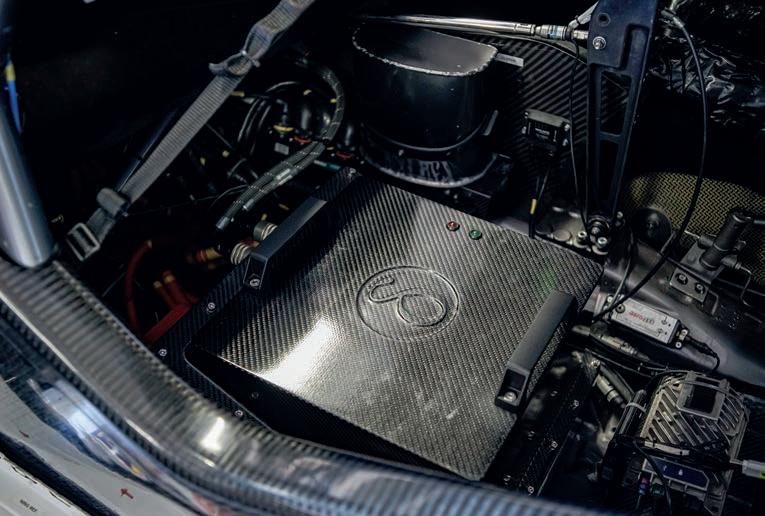
The 23kg Delta-Cosworth battery pack is positioned alongside the driver, with all the regular safety protocols adhered to
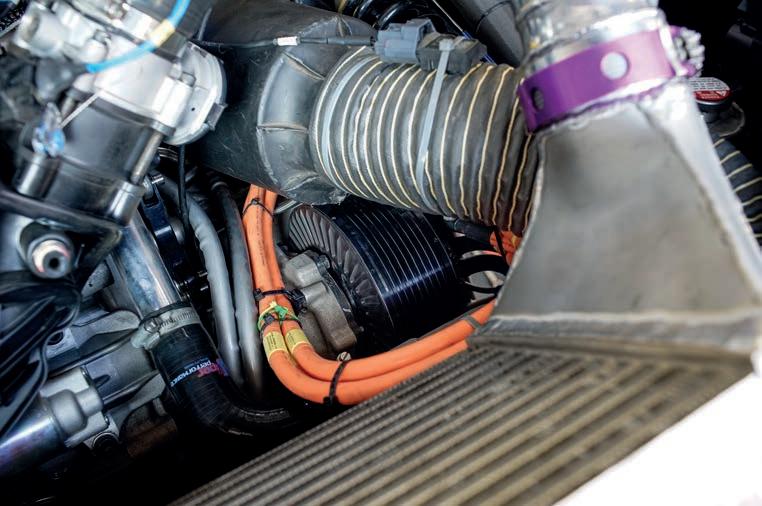
The three-phase electric motor is mounted in the P2 off-axis configuration inside all entries in the BTCC
Strategy element
The system’s regeneration is designed this way so an element of strategy is required for all the teams with hybrid deployment capability. Towards the end of the race, drivers will run down the battery’s state of charge (SOC) so, even for teams who have the full 15 seconds per lap deployment for the race, by the time they reach the chequered flag, they will be starting to run low on SOC. Those with fewer deployment laps must decide whether they choose to deploy early or later in the race, making sure they maximise their available deployment.
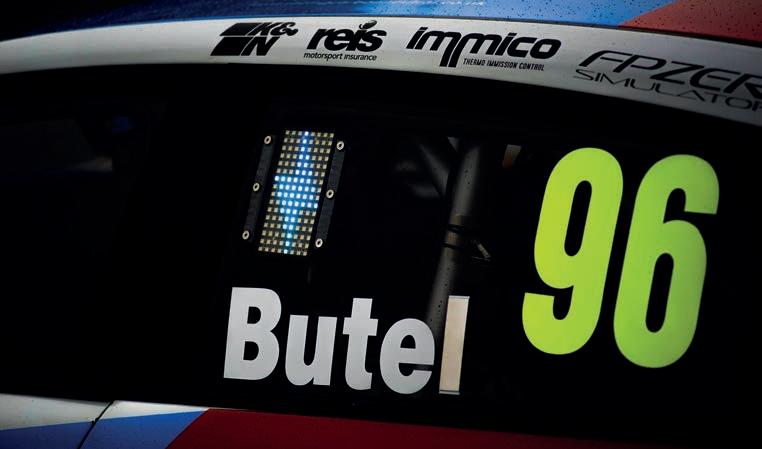
A flashing blue lightning bolt illuminated in the window shows fans and spectators when the hybrid system is being used
Richard Woodgate
‘Strategy has been lacking in BTCC in previous years because, generally, all the cars have been so competitive. It has just been all-out racing,’ says Woodgate. ‘That’s good because it’s what makes the spectacle, and the new cars haven’t changed. It’s just they’ve got this addition now with the hybrid. How drivers and teams decide to use it on top of the already exciting racing adds another dimension.
‘Most drivers and teams are now starting to realise when is the best time to use the torque available. On some circuits, it seems obvious, but on others it is still a challenge. Some teams have employed people to help them make the most of it, and others have to learn it race to race.
‘Additionally, TOCA does a good job of keeping the parity between the internal combustion engines so close that it is obvious when drivers use the hybrid.’
During a race, the status of the hybrid system is indicated to the driver on the Cosworth display in the cockpit. LED light panels in the side windows are used to display hybrid activation to fans, but currently have no diagnostic feature for the system
‘The choices the BTCC made in terms of data access goes back to having to make the car a very solid, user-friendly machine,’ explains Woodgate. ‘Because nobody in the pit lane can see the car’s status, it needs to flag any issues and then shout the message at the driver.’
Driver input
‘With the hybrid system on board now as well, drivers have a lot of new responsibilities, including handling the SOC of the battery, deployment and managing its usage across a lap, and the number of laps they can use it. The Cosworth display shows everything on the screen in front of them, but they have a job on their hands now.’
When it comes to using the hybrid deployment, there is a specific window within which it can be deployed, and Cosworth has tried to make it as simple as possible. The driver must meet certain criteria, including throttle position, speed and gear before using the electric drive. Once they’ve achieved that, all they do is push a button.
‘Teams are allowed to build their alarms, messaging, lights or whatever they want to indicate to the driver that they can deploy,’ notes Woodgate. ‘A lot of them have gone with a status LED that, when lit, means the driver can deploy. However, also managed in the software is a penalty system. If the driver presses the deployment button below one of those criteria, it adds a delay before deployment engages. That is to prevent drivers sitting on the button and letting the system come on automatically when all those criteria are met, taking out the driver element.’
What the system does take care of automatically is the 12 per cent regeneration per lap. TOCA didn’t want teams to be able to calibrate or adjust that. Regeneration occurs off throttle above a specific rpm and below a certain amount of throttle. Part of the calibration of regeneration was to ensure the car’s deceleration felt natural.
‘Our biggest concern was rear-wheel drive regeneration because, obviously, the characteristic for the front-wheel-drive is that we could probably put more torque across the front axle and not affect braking at all,’ says Woodgate. ‘But with rear-wheel drive, where weight transfer takes place, the driven axle gets lighter.
‘The fact is, we can generate a maximum of about 20Nm of torque under braking with both in its current configuration if we need it. We could increase it to 35 or 40Nm of brake torque and start to pull back nearly double in terms of power with this system, but this first season is set out already, and again we are being conservative.
‘Most drivers have said, with the system off or on, they can’t feel the regenerative braking input at the wheel.’
A small amount of contact is always expected within the very close racing environment of the BTCC, and this formed part of the development process.
‘Crashing was one of our biggest reliability concerns, having two radiators in the front bumper,’ says Woodgate. ‘Front bumper real estate is hard to come by with a turbocharged ICE with an intercooler and radiator already. So all the available frontal area is used for that. Our coolers are a lot smaller and are fitted under the subframe on the corner extremities.
‘Sadly, there’s not a lot you can do if, or when, an on-track incident takes place. You’ll probably be okay if it’s one lap from the end of the race. If it isn’t, then a driver will probably have to come in. That’s just a factor of racing in the BTCC.’ l
BTCC
